Acknowledgments
This book wouldnt have been possible without the seminal work of a number of researchers whove dedicated their professional lives to understanding the problem of compulsive hoarding and to developing ways to help those who suffer with it. Although this is a long list, we want to thank, in particular, Randy O. Frost, Gail Steketee, and David F. Tolin for their generous and consistent support of our ideas.
We thank Belinda Lyons, executive director of the Mental Health Association of San Francisco (MHA-SF), for her enthusiastic support of our book. In addition, we acknowledge MHA-SF and its key role in disseminating information about compulsive hoarding. We thank the members of the San Francisco Task Force on Compulsive Hoarding, under the aegis of the San Francisco Department of Aging and Adult Services, MHA-SF, and other professionals, for their support of this project. These professionals include Gary Hartz, Thomas L. Hafemeister, Joe Cuff, Martha Legallet, Joel Liberson, Jason Wolford, Cindy E. Rasmussen, Aregawie Yosef, and Monika Eckfield. We also thank Alan and Linda Merrifield of Peninsula Community Services for maintaining an informative website devoted to providing resources for people who hoard and their families.
We thank our editor, Tesilya Hanauer, for her enthusiastic support of this book and for her tolerance of our many missteps along the way. We thank Jess Beebe, senior editor at New Harbinger, for improving the quality of the book in general.
I, Michael, thank my colleagues at the San Francisco Bay Area Center for Cognitive Therapy, beginning with Jacqueline B. Persons, director, who continues to encourage me to try things that seem to me to be just beyond my reach. I thank my other colleagues at the center (Joan Davidson, Janie Hong, Katherine Martinez, and Daniel Weiner) for their continued support of my professional development. I would also like to thank my wife, Luann L. DeVoss, and my daughters, Madeleine and Olivia, for tolerating yet another book project. They are troopers and I love them dearly.
I, Tam, thank my colleagues at the VA Palo Alto Health Care System (Judith Chapman, Bob Hall, and Jeanette Hsu) for their ongoing support, and Jim Moses for being the first person to order the book before we even completed it. I also thank Randy O. Frost, George J. Allen, and Toni Zeiss for their invaluable mentorship along the way. I thank my husband, Stuart, for giving me the time and space for writing, his earnest interest in the work itself, and his ingenious idea of a reward system that included Indian food when I completed milestones in the writing project. He truly embodies the meaning of life partner and makes me feel lucky every day. Finally, I thank my mother, Beverly, and my sister, Kristin, for being wonderful role models, for their love and support, and for rooting for me in this and all endeavors.
Finally, we acknowledge those whove taught us the most about the problem of compulsive hoarding: those who suffer with the problem and the family members and friends who love them. They have enriched our lives through their trust and inspired us by their courage and determination to better their situations. We have altered the descriptions of clients, family members, professionals, and our work with them to protect their privacy.
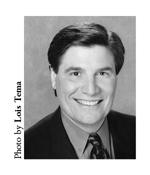 Michael A. Tompkins, Ph.D., is a licensed psychologist and a founding partner of the San Francisco Bay Area Center for Cognitive Therapy, an assistant clinical professor at the University of California, Berkeley, and a founding fellow of the Academy of Cognitive Therapy. He has authored and coauthored numerous articles and books on cognitive behavior therapy and related topics, including My Anxious Mind: A Teens Guide to Managing Anxiety and Panic and the book and video series Essential Components of Cognitive-Behavior Therapy for Depression. He has presented nationally on the topic of compulsive hoarding and is a member of the San Francisco Task Force on Hoarding. He specializes in the treatment of anxiety disorders in adults, adolescents, and children and is in private practice in Oakland, CA.
Michael A. Tompkins, Ph.D., is a licensed psychologist and a founding partner of the San Francisco Bay Area Center for Cognitive Therapy, an assistant clinical professor at the University of California, Berkeley, and a founding fellow of the Academy of Cognitive Therapy. He has authored and coauthored numerous articles and books on cognitive behavior therapy and related topics, including My Anxious Mind: A Teens Guide to Managing Anxiety and Panic and the book and video series Essential Components of Cognitive-Behavior Therapy for Depression. He has presented nationally on the topic of compulsive hoarding and is a member of the San Francisco Task Force on Hoarding. He specializes in the treatment of anxiety disorders in adults, adolescents, and children and is in private practice in Oakland, CA.
Tamara L. Hartl, Ph.D., is an independent clinical practitioner in Saratoga, CA, and a psychologist at the VA Palo Alto Health Care System. She has coauthored several seminal publications on hoarding behavior, including the first cognitive-behavioral model for the treatment of compulsive hoarding with Randy Frost. She specializes in the treatment of anxiety disorders and sexual dysfunction as well as compulsive hoarding.
Foreword writer Randy O. Frost, Ph.D., teaches abnormal psychology at Smith College in Northampton, MA. He is coauthor of Buried in Treasures.
Foreword writer Gail Steketee, Ph.D., is a professor and co-chair in the department of clinical practice at the School of Social Work at Boston University. She is coauthor of Buried in Treasures.
Chapter 1
What Is Compulsive Hoarding?
We all have stuff: a kitchen drawer filled with old thumbtacks, rusty door hinges, or spools of thread that we keep just in case. Over the years, if we arent thoughtful about what we keep and what we discard, our garages, closets, and drawers fill with more and more stuff. We tell ourselves well get around to clearing it out someday, but we never do. Yes, we all have stuff. But when does our stuff become a problema problem for us and for the people who love us?
In this chapter, we define compulsive hoarding to help you better understand what it is and what its not. We present four problem areas at the core of compulsive hoarding that we hope will explain why your loved one appears to cling desperately to her possessions and why the problem has worsened over the years. If youre uncertain whether your loved one has the problem, well present some signs to look for. We then present other conditions that may exist along with hoarding behavior.
Defining Compulsive Hoarding
Norman is eighty-eight years young, as he likes to joke, and few people would disagree with that assessment. He has the energy and interests of a twenty-eight-year-old. He tells anyone wholl listen about his years in Paris as a struggling art student and about his lifelong love of everything beautiful. Norman once owned a large graphic design company, but now that hes retired, he fills his days by collecting artand anything else that his lively and creative eye catches. He has filled his home with postcards advertising gallery exhibits that opened forty years ago, interesting photos and pictures clipped from magazines and newspapers over the years, scraps of colorful cloth, buttons with a special sparkle, and even old cereal boxes with interesting pictures on the front. His son and daughters have grown more and more alarmed with his collecting, particularly because it appears to have worsened since his wife died. Theyve suggested that he give some things to them or that he donate some of his cherished collection to a local art school, but he seems overwhelmed by the idea of getting rid of anything, even the smallest postcard. Does this sound like your family member? If so, your loved one might be suffering from compulsive hoarding.
Compulsive hoarding appears to be a common problem. Researchers estimate that the problem occurs in about four to five out of every thousand individuals throughout their lifetimes (Samuels et al. 2008). The prevalence of hoarding symptoms among people with dementia may be substantially higher (Hwang et al. 1998). Because hoarding symptoms accompany a wide range of mental health conditions, and because, in many cases, the sufferer hides the condition out of fear of discovery, the true prevalence of hoarding may be much higher than current estimates suggest.


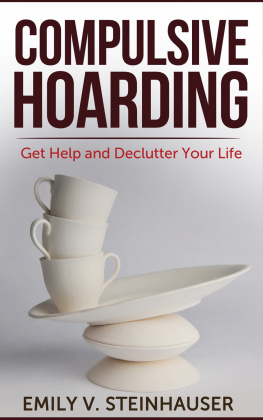

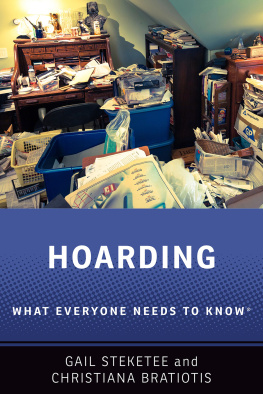
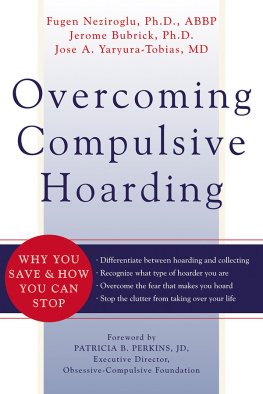
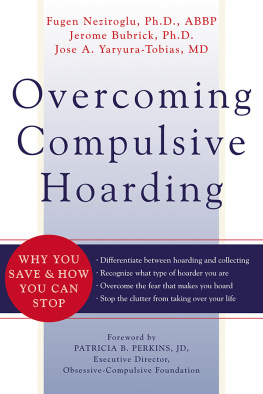
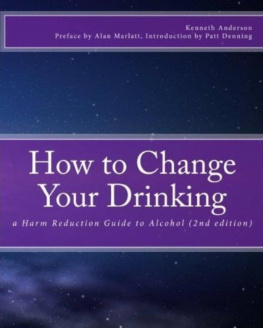

 Michael A. Tompkins, Ph.D., is a licensed psychologist and a founding partner of the San Francisco Bay Area Center for Cognitive Therapy, an assistant clinical professor at the University of California, Berkeley, and a founding fellow of the Academy of Cognitive Therapy. He has authored and coauthored numerous articles and books on cognitive behavior therapy and related topics, including My Anxious Mind: A Teens Guide to Managing Anxiety and Panic and the book and video series Essential Components of Cognitive-Behavior Therapy for Depression. He has presented nationally on the topic of compulsive hoarding and is a member of the San Francisco Task Force on Hoarding. He specializes in the treatment of anxiety disorders in adults, adolescents, and children and is in private practice in Oakland, CA.
Michael A. Tompkins, Ph.D., is a licensed psychologist and a founding partner of the San Francisco Bay Area Center for Cognitive Therapy, an assistant clinical professor at the University of California, Berkeley, and a founding fellow of the Academy of Cognitive Therapy. He has authored and coauthored numerous articles and books on cognitive behavior therapy and related topics, including My Anxious Mind: A Teens Guide to Managing Anxiety and Panic and the book and video series Essential Components of Cognitive-Behavior Therapy for Depression. He has presented nationally on the topic of compulsive hoarding and is a member of the San Francisco Task Force on Hoarding. He specializes in the treatment of anxiety disorders in adults, adolescents, and children and is in private practice in Oakland, CA.